A/B testing in Google Ads is crucial when it comes to creating successful campaigns. It allows you to experiment with different variables, from bid strategies, ad headlines and images, to final URLs (and more), to learn what works best.
When it comes to images in Google Ads, A/B testing is especially important. The right image will be on brand, catch a user's eye, convey your message effectively, help you stand out from competitors and ultimately lead to better performance.
A study found that when image extensions were served with search ads there was, on average, a 10% increase in click-through rate, which highlights how effective the right image can be. By running A/B tests with images, you can gather valuable learnings and insights into what performs best and in turn, optimize accordingly.
What is A/B Testing in Google Ads
Let’s start with the basics of Google Ads A/B testing for a search on Google. Essentially, it’s a method of testing two different versions of an ad or campaign, to determine which one performs best. Google Ads provides several options for A/B testing, and the abundance of data makes it easier to analyze results and make decisions informed by your data.
One really important aspect of search A/B testing is to give the tests enough time to gather sufficient data for accurate insights. There's no set rule for how long to run an A/B test. The length of time needed can depend on factors such as budget and the size of the audience being targeted.
With a larger budget, you'll generally collect data more quickly and be able to draw conclusions sooner. Whereas with a smaller budget, you may need to run the test for a longer period to get reliable results.
3 ways to A/B test in Google Ads
There are three ways to A/B test in Google Ads, all of which are effective for different reasons and all can be applied to images in Google. It's common to use a mix of all three when managing a Google Ads account.
1. Google Ads ‘Experiments’ Tab
The Google Ads ‘Experiments’ section is a great way to run controlled campaign experiments. In this section, you can select predefined Google Ads experiments, such as testing an ad variation or testing different videos. Or you can choose to do a custom experiment and test a variety of things, such as bid strategy and bid adjustment, keyword match types, ad schedule, audience targeting and landing pages.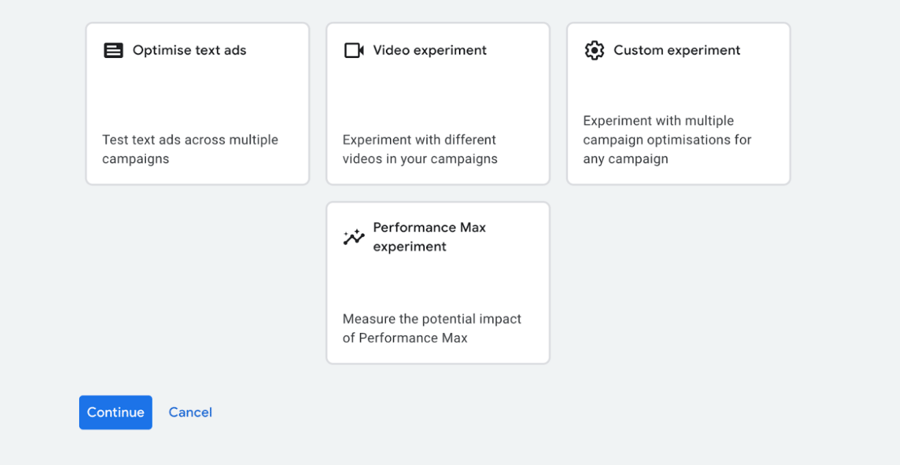 Google Ads experiments | Google Ads
Google Ads experiments | Google Ads
When setting up a Google Ads experiment, you’ll first choose your base campaign, which represents ‘A’. This will create a duplicate of the campaign, and that duplicate version is ‘B’.
You must then make changes to the ‘B’ campaign, for example if you would like to experiment with landing pages, go ahead and implement the test landing page in the ‘B’ campaign. Then specify start and end dates and how much traffic you would like to send to both ‘A’ and ‘B’. 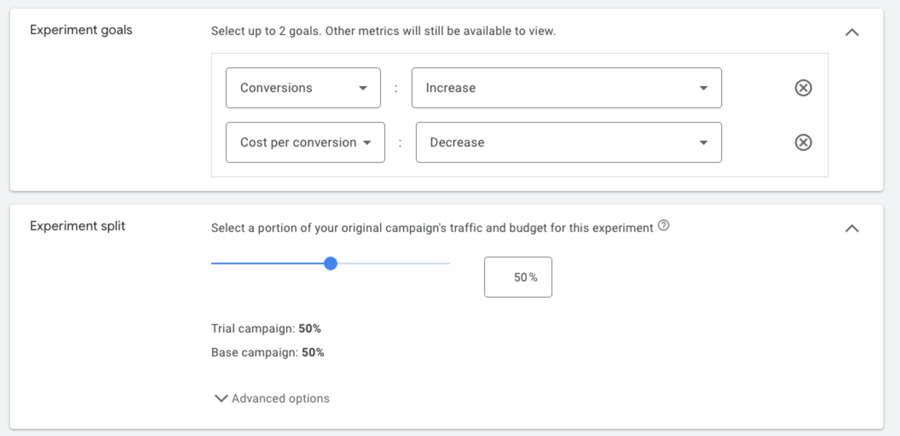
Picking goals for Google Ads experiment | Google Ads
Google will then serve the experiment campaigns to people in your target audience and over time, provide you with the results.
What’s great about running Google experiments is that you’ll be prompted when the result is statistically significant, meaning you can have confidence in the results. If not enough data is collected for the result to be statistically significant, the result will be shown as inconclusive. If this happens you can still achieve a good indication of performance.
This was an inconclusive experiment, however, the KPIs improved and it was still an insightful experiment:
Partly inconclusive, but this experiment still provided insight into how an alternative bidding strategy impacted performance:

Following a Google Ads experiment, if you ‘Apply Experiment’ it will update the base campaign with the changes made in the experiment. Or you can ‘end’ or ‘remove’ the experiment if you do not wish to apply the changes.
2. Manual Google Ads A/B Testing and Analyzing Data
The process of manual Google Ads testing involves analyzing data at various levels such as keyword, ad group, asset, ad, audience, and landing page, among others. While not as formal as using the Experiments tab, it is still an effective way to continually a/b test on Google and optimize campaign performance.
For example, you can analyze ad extensions (which are now referred to as assets) by looking at the performance of each asset to determine those that are performing best and those that are underperforming. Optimize them by removing the underperformers and further develop the top performing assets based on what resonates with your audience.
3. Third-Party Tools to A/B Test
Google Ads experiments are predominantly focused on Google Search and Display campaigns, with an exception of using ‘One click target ROAS’, which allows you to experiment with using Target ROAS for Shopping campaigns.
However, there are third-party tools that can assist with A/B testing your Google Shopping campaigns, such as DataFeedWatch. In particular, DataFeedWatch lets you run A/B tests for Google Shopping titles and images, as well as being a tool that allows you to create perfectly optimized product feeds for your ad campaigns.
If you are running Google Shopping, it’s best practice to leverage third party tools to experiment with various elements of your shopping campaign.
Where To Use Images in Google Ads
In today's digital landscape, visual content has become more important than ever. Images are now a central part of the user experience and consumers expect high-quality visuals from brands across all touchpoints. This trend has extended to advertising.In Google Ads, images can be used in a variety of ways to enhance your ads and campaigns.
- Display Ads contain image assets, whether they’re responsive ads or uploaded banners, and these ads are served across the Google Display Network (GDN)
- Performance Max campaigns use image assets in very much the same ways as Display Ads, and if using a product feed, they are the same as Shopping Ads but known as Listing Groups
- Google Shopping image assets are used to create compelling visual ads that showcase products
- Image Extensions (or Image Assets) allow advertisers to showcase additional visuals alongside their Search Ads
How to A/B test images in Google Ads
Let’s dive into some of the best practices around a/b testing images on Google Ads, looking at Display, Performance Max, Google Shopping and image assets that are part of search campaigns. The method of a/b testing differs slightly for each campaign type, but image testing itself is of equal importance.
Image A/B Testing in Google Display Campaigns
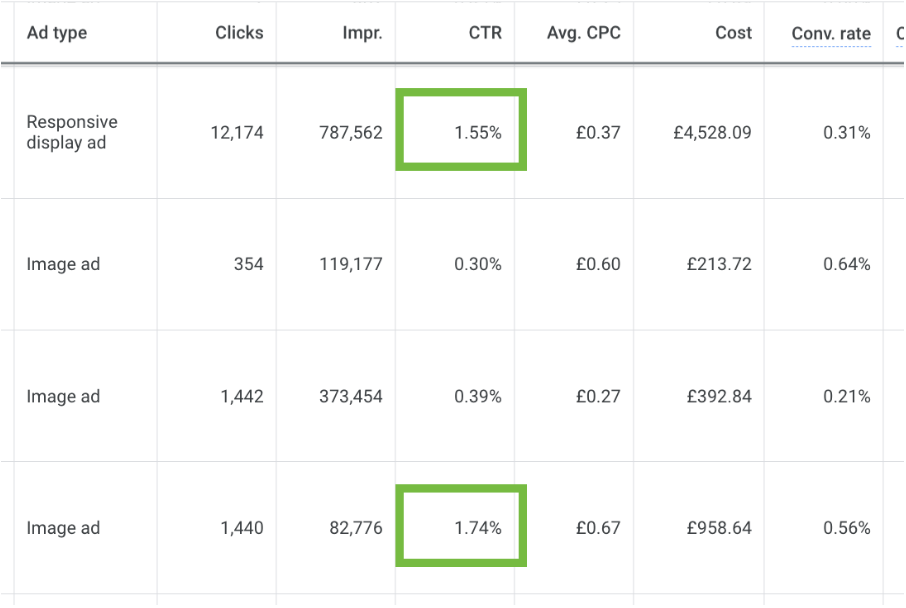
Google Ads experiment's results | Google Ads
When it comes to A/B testing images in GDN campaigns, it’s similar to testing for a search campaign but there are differences. The ad variation feature in the Google Ads Experiments tab is limited to search ads only, so the main way to test Google Display ads is by manually creating two separate ads within the same ad group.
- In your campaign, build two separate ads within the same ad group. Ad 1 should feature one image and ad 2 should feature the other image you would like to test.
- Use the same headlines, descriptions, and call-to-action text, but with different images. This ensures that the only variable being tested is the image, and nothing else will influence the results
- In campaign settings, make sure the campaign is set to 'Do not optimize: Rotate ads indefinitely’, which tells Google to serve the ads equally and give them a fair chance to be tested
- Once the ads are launched, leave them to run and gather as much data as possible. It's important to note that performance may fluctuate from day to day, so it's best to give the test as long as possible.
- When you're ready to analyze the results, focus on KPIs like CTR, conversion rate, CPA, and ‘return on ad spend’ to determine which image generated the best results. CTR is especially important for image testing since images are visual and their purpose is to encourage and entice users to click
Image A/B Testing for Performance Max Campaigns
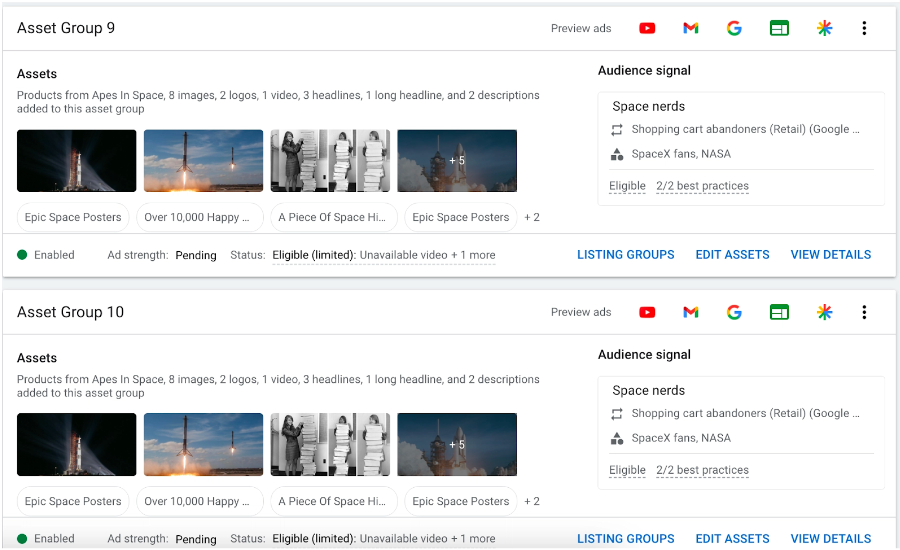 Setting up audience signals | Google Ads; Source: Storegrowers
Setting up audience signals | Google Ads; Source: Storegrowers
Performance Max campaigns use image assets in the same way as Responsive Display Ads. In PMax campaigns, ads are referred to as Asset Groups. An asset group is a collection of creatives centered on a theme or related to a target audience. Since asset groups can be split into themes, you can A/B test Google image assets by adding them to separate asset groups.
Let’s say a holiday website wants to A/B test lifestyle images that include people in one version and showcase the accommodation in the other version. They could build two asset groups, one with people in the image and one without people.
Unfortunately, there are limitations to how granular the data reports are for PMax campaigns, and it’s not possible to see KPIs such as CTR, conversion rate and ROAS for each asset group in the same way you can for Search and Display ads.
To get insights into the performance of the two types of images, first, review the ad strength of both asset groups and aim for an ad strength of ‘good’ or ‘excellent’. Then click into the asset group by clicking ‘view asset details’. Here you’ll get insight into how each element of the PMax ad performs. Pay attention to the performance column and take out assets with a performance score of low to focus on the best-performing assets. 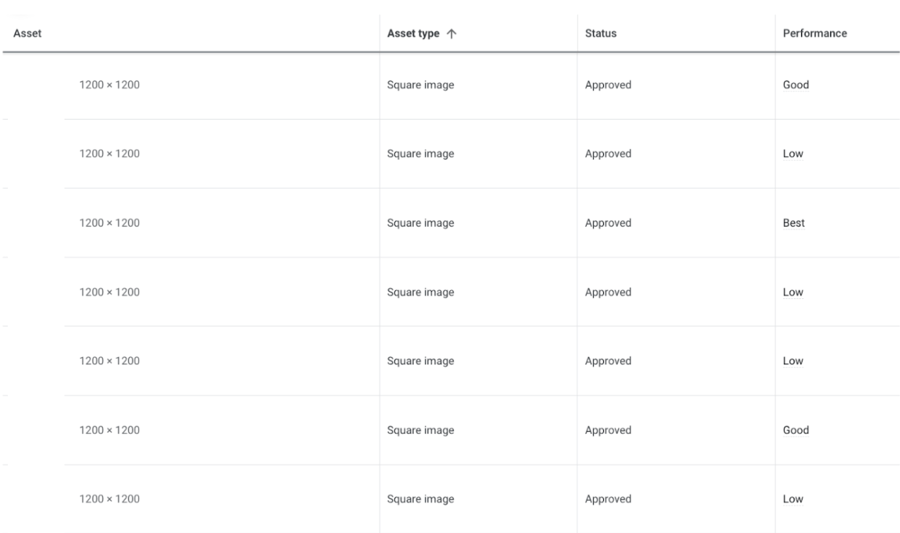
Checking Performance Max asset performance | Google Ads
Back to the example for the holiday website, analyze the performance score of each asset type (those with and without people) to work out which image assets drive the best performance.
5 Asset Group Best Practices
- Check the ad strength indicator to make sure your asset group has enough assets to perform well
- Include all of the different types of assets, such as text, images, and videos, in each group to ensure maximum coverage
- Ensure that all assets meet the quality guidelines set by Google
- Experiment with different variations of assets to identify the top-performing creative, as discussed above relating to image assets
Image A/B Testing for Google Shopping
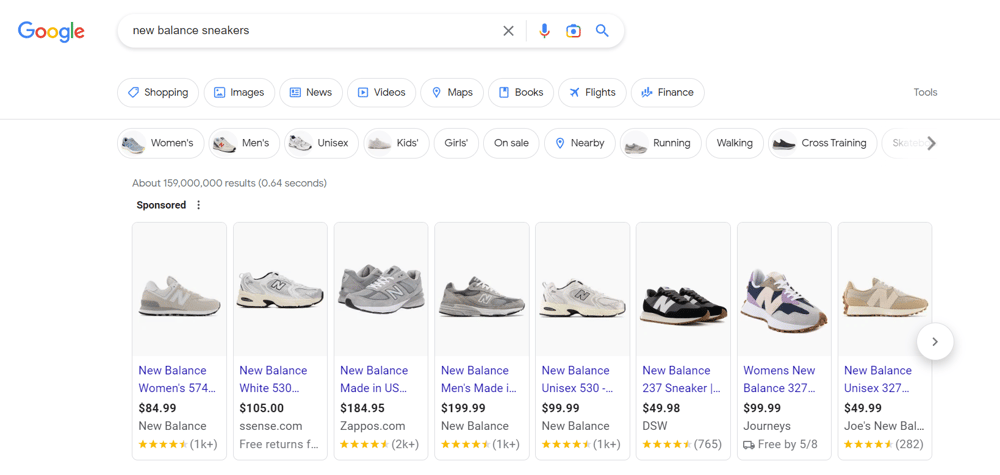
Example of Google Shopping ads | Google Ads
For Google Shopping campaigns, including PMax campaigns that are using a product feed which then form PMax Listing Groups, A/B testing product images is a fundamental way to improve campaign performance. While there aren’t image testing capabilities in Google Ads directly that allow advertisers to do this, you can A/B test Google images using the third part tool DataFeedWatch.
You can test which images work best, whether that be lifestyle, product, plain background or action shots, by allocating your products into two (or more) groups.
When using DataFeedWatch you can create a custom label in your Master Fields to divide your product set into two groups: product set A and product set B
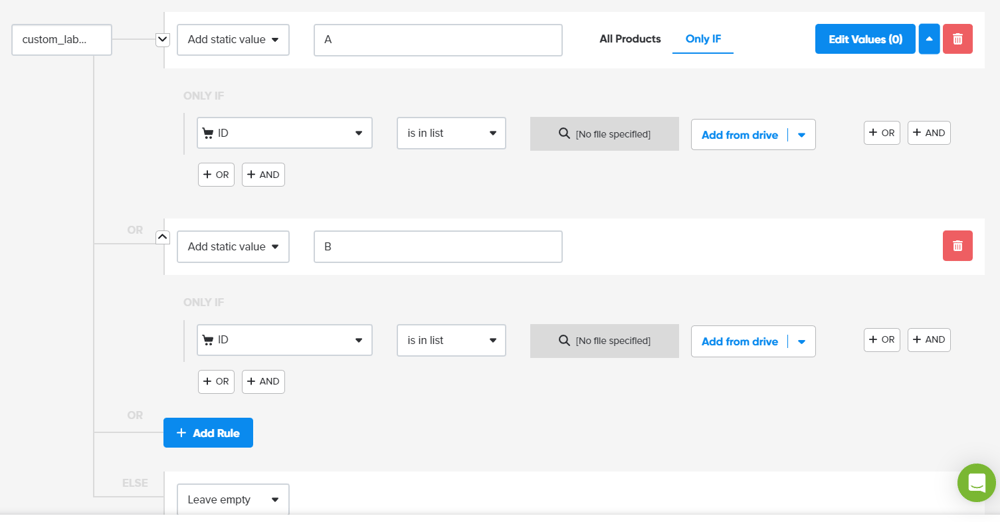
Creating custom labels | DataFeedWatch
Then, using a simple rule, we can match these groups with specific images. For example, If a product with ID 2345 is in the list, it belongs to Products A. You match the first group of products with image_url_2 and the second group with image_url_4. This way the first group of images you want to test is under image_link_2, and the second group is under image_link_4.
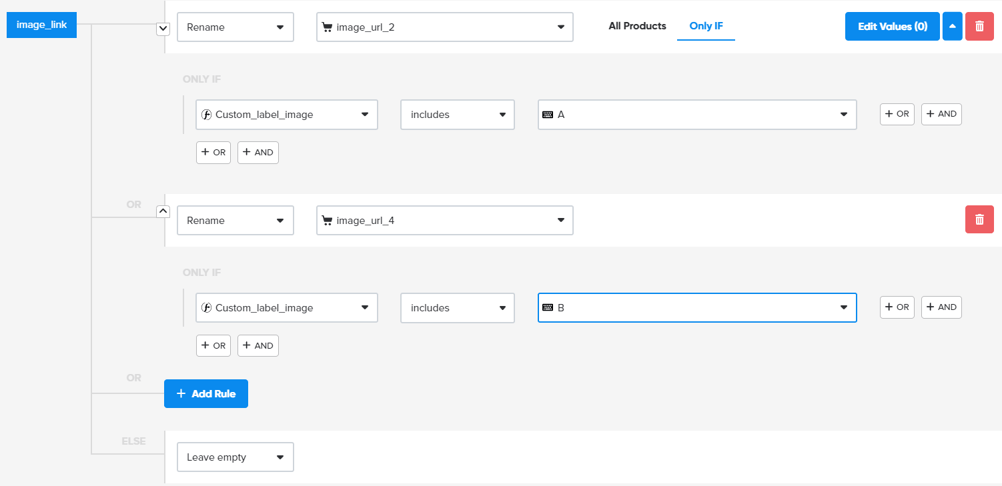
Mapping image_link | DataFeedWatch
Based on the specific custom labels that you’ve created, you can track the results of ads in GA4 with specific images and determine which ad is more successful.
Need help with your Google Shopping images? Here are 7 Rules To Abide By with your Google Shopping Images.
A/B Testing Image Assets (formally ad extensions)
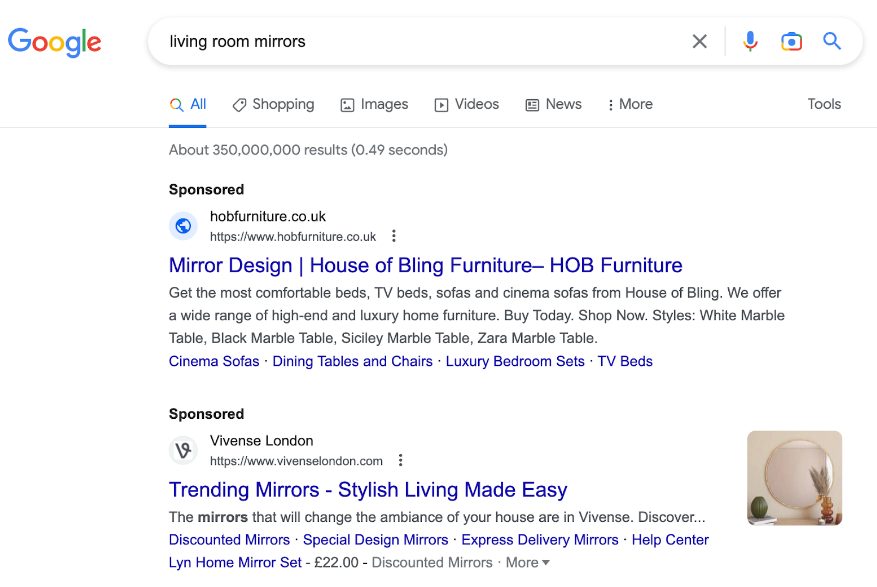
Example of ad extensions | Google Ads
A/B testing for a search campaign’s image ad extensions (which are now referred to as assets) is manual and involves analyzing data at the asset level. Select ‘Image’ assets and then analyze your KPIs to determine the best-performing image assets (it’s the same process for analyzing all asset types).
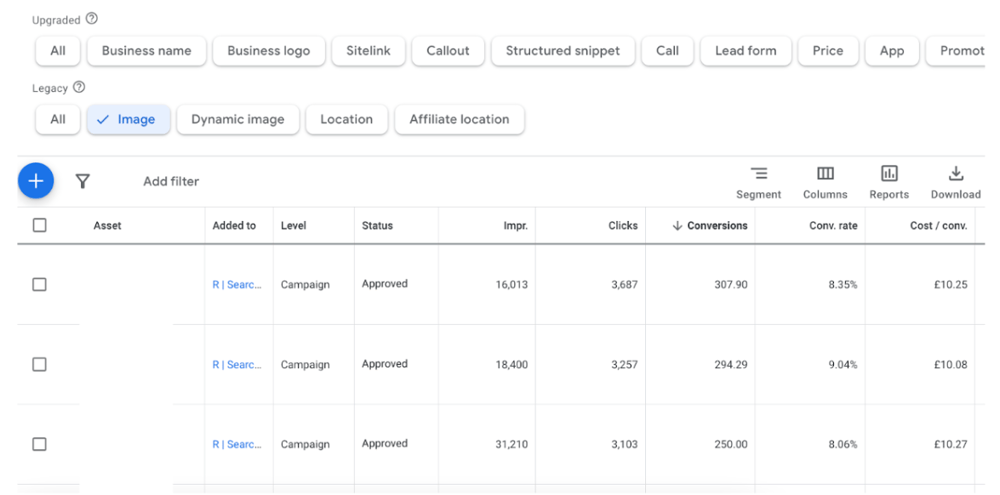
A/B testing image extensions | Google Ads
It’s important to consider both click and conversion metrics if your objective is conversion-based. In the screenshot below, I’ve highlighted the image assets that should be removed from the campaign due to having a lower-than-average CTR and higher-than-average CPA.
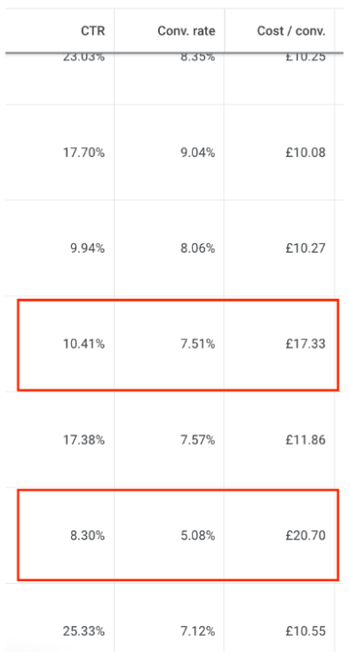
Further analyses can be carried out into the images such as trying to work out why the two above are underperforming and why the other images are performing better. This could be followed up by introducing more images and further testing whether they improve performance.
It's important to note that image ad extensions are not guaranteed to show up in every ad impression. So it may take longer to gather enough data, but over time you can determine which extension is performing better.
Image A/B testing – Best practices
Here are some of the key Google Ads image a/b testing best practice to bear in mind when running a/b tests on Google.
Duration of Image A/B Tests
When it comes to the duration of a/b testing, the recommendation isn’t based on time. Instead, how long your a/b test lasts should be based on data. It’s vital that you give your tests enough time to gather enough data in order to make an informed, data-backed decision.
Let’s say your ad spend is £100 per day, and the image assets you are testing only receive a portion of that ad spend, as there will likely be more than just the two image assets in play. It’s going to take a minimum of weeks, if not months, to gather enough data to conclude your Google Ads experiment. However if your campaign is spending £1,000+ per day, you will probably be able to conclude the experiment within a week due to the higher volume of data.
Remember, when running Google Ads experiments using the ‘Experiments’ tab, you’ll be notified when there’s been enough data for the test to be statistically significant.
Testing Variables
There are a large number of variables that could be tested in your image assets and it really does depend on what makes sense to you based on your creatives and objective. Some common things that could be tested include:
- The use of different colors in image assets
- Different visuals to determine which ones resonate best, for example graphic VS lifestyle, or people VS no people
- Different types of text overlay on the images (where applicable)
- The impact of branding elements in the image versus not including them
- How different placements of the call-to-action button impacts CTR
Image Sizing and Specs
Image sizing and specs depend on where the image is being used, as it differs depending on campaign type and placement. If you are uploading animated and non-animated display ads as banners, all of the specifications can be found here.
For image assets as ad extensions the full specifications can be found here. See here for responsive display ads and performance max campaign image asset requirements and specifications. In all instances it is recommended that both square images and landscape images are used in order to maximize the placements your images are eligible for. In PMax campaigns, it is recommended to also include portrait images.
Here’s an overview of the specs:
- Landscape (1.91:1): 1200 x 628 pixels
- Minimum image size: 600 x 314 pixels
- Maximum file size: 5120 KB
- Square (1:1): 1200 x 1200 pixels
- Minimum image size: 300 x 300 pixels
- Maximum file size: 5120 KB
- Portrait (4:5): 960 x 1200 pixels
- Minimum image size: 480 x 600
- Maximum file size: 5120 KB
Conclusion
With numerous ways to incorporate images into your Google Ads campaigns, its vital advertisers strive for the best possible performance by introducing an image search A/B testing strategy. It’s best practice to adopt an A/B testing mindset from day 1 to drive the best possible result.
Here are several benefits to using images in your Google Ads campaigns to conclude this article:
- It’s been proven that images do enhance Google Ads performance. With this in mind, not experimenting with image assets at every opportunity would be missing a trick
- Images in Google Ads allow advertisers to convey information visually, which can be challenging to do with just using text. This may help audiences digest that information quicker, which is good from a short attention span perspective
- The use of images is wise from a branding perspective. Whether your brand already has high recognition or you would like to develop your branding, images help build branding and consistency
- Images are versatile and using and testing images in Search ads enables your campaigns to run on more platforms. This is because image assets can serve on YouTube Search via the Search Partner Network (AFS)

